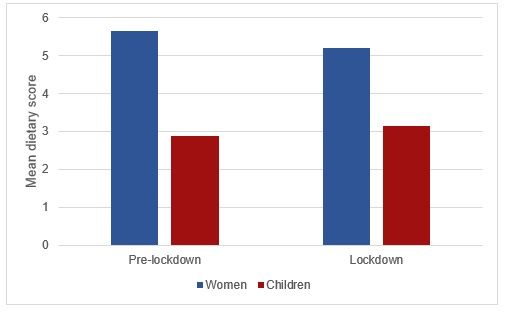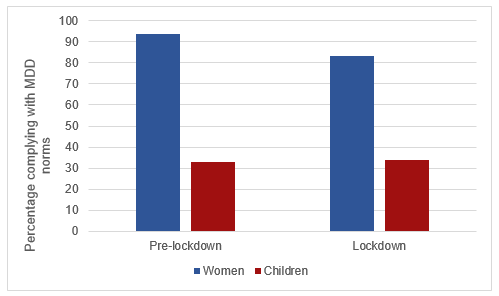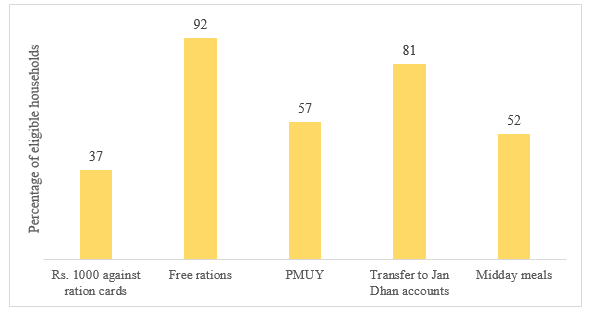Lockdowns imposed to contain the spread of Covid-19 led to loss of employment and income. They also created greater food insecurity, with women and children being more vulnerable to such shocks. In this context, based on surveys in rural Bihar, Husain et al. discuss the impact of the lockdown on the dietary practices of women and children, and how these were impacted by their access to government welfare programmes during this period.
When lockdowns to contain the spread of Covid-19 were first instituted, they were widely expected to have a substantial impact on food and nutrition security (Summerton 2020), which led to predictions of unprecedented economic depression, deflation, large-scale unemployment, shrinking income, and increase in poverty. Projections indicated that the number of people below the poverty line would increase by 140 million, of which 42 million would be from South Asia (Laborde et al. 2020). Researchers also expected a substantial effect on both the levels and composition of consumption – they thought that women and children were likely to be affected the most (Scott et al. 2020, Swinnen and McDermott 2020), particularly with disruptions in nutrition services.
Countries like India were expected to be adversely affected by lockdowns. Because of their poor ranking in the Global Hunger Index, food security was in question even pre-pandemic and – this vulnerability was compounded by the stringent nature and scale of Covid-19 restrictions imposed. Regions such as Bihar, known for their historically poor record of maternal and child health indicators, and dysfunctional delivery of welfare schemes, were especially vulnerable. Early studies on the impact of Covid-19 revealed bleak outcomes – with households reporting job losses, hunger, and liquidity problems.1 Such studies, however, relied on unvalidated, self-reported responses elicited through telephonic surveys undertaken during the lockdown. Since these responses were collected using snowballing, purposive and other non-random sampling methods, the extent to which the findings apply to the general population is, therefore, doubtful.
The study
We examine the extent to which the Covid-19 lockdown affected the dietary practices of women and children, and quantify the change in their welfare (discussed more fully in Husain et al. (2022a)). We also look at whether households were able to access government programmes to mitigate the adverse effects of the lockdown, and if political connections of household members play a role in this regard (Dutta et al. 2021).
We use data from two primary surveys conducted in six districts of Bihar using a multi-stage random sampling design.2 The baseline survey, conducted in January-March 2020, covered 2,250 randomly selected women aged 15-49 years with at least one child below the age of three. We re-surveyed a sub-sample of 1,148 women over the telephone in October-November 2020.
We compare the frequency of consumption of eight major food groups3 between the two periods. If respondents, or their children, consume at least four of these eight food groups, we consider it as fulfilment of the minimum dietary diversity (MDD) norms. We also estimate their dietary score (DS) based on how many food groups they consume (Swindale and Bilinsky 2006). In addition, we elicit information on the coverage of respondents under welfare measures like take-home rations (THR) through the Public Distribution System (PDS)4, Pradhan Mantri Ujjwala Yojana (PMUY), Jan Dhan Yojana (JDY), and Midday Meal scheme.5
Impact of the lockdown on nutrition and food security
We show that the overall effect of the lockdown on dietary practices of women and children in rural Bihar, while serious, does not seem to be as disastrous as portrayed in other, earlier studies on the impact of Covid-19 (see Footnote 1). The percentage of women complying with MDD norms declined by 11 percentage points between the pre-lockdown period and during the lockdown (Figure 1). Among children aged 7-36 months, the proportion conforming to MDD norms remained the same, at around one-third. The average number of food groups consumed out of the eight food groups changed from 5.65 to 5.20 (for women) and from 2.89 to 3.15 (for children).
Figure 1. Average dietary scores among women and children
Analysis by sub-groups reveals that both DS and MDD have declined the most among households holding fewer assets, and among households from Hindu upper castes and Other Backward Classes. Compliance with MDD norms has also declined substantially among women with no education. We also find that non-vegetarian food items, dark green leafy vegetables, and other fruits and nuts, were substituted by cereals and pulses.
Figure 2. Percentage of women and children satisfying minimum dietary diversity norms
The baseline survey revealed that the dietary intake of children is low, with only one out of three children complying with MDD norms, with an average of 2.89 food groups consumed out of eight. These indicators improved very marginally over the study period from 33% to 34%. We found that cereals, pulses, and milk and dairy products were the main items consumed by children. Analysis of the change in dietary practices of children by age group indicates that the slight increase in dietary intake during this period may be attributed to the children growing older, and being weaned away from breast milk. Analysis of changes in DS and MDD, by age group, shows that both have declined among children aged 25-36 months (that is, children who had already been weaned off breast milk at the time of the baseline survey).
Although our findings show that the short-run impact of the lockdown on nutrient intake is less alarming than what was expected, the dietary practices followed by mothers and children during the lockdown may lead to a deficiency in micronutrients due to lack of consumption of fish and meat, eggs and green leafy vegetables. Studies have shown that micronutrient deficiency may lead to lower learning outcomes and retention, and increase morbidity and mortality in the long run (Branca and Ferrai 2002, Rivera et al. 2003).
Change in welfare of mothers and children
The change in the welfare of respondents and their children was estimated using the information on pulse consumption for ration card holders using the Willingness to Pay approach. For the pre-lockdown and lockdown periods, a consumer surplus was estimated– defined as maximum willingness to pay less the time taken to collect THRs from the PDS outlet (that is, the opportunity cost to collect rations). Since consumer surplus is considered a measure of welfare, the change in consumer surplus indicated the change in welfare due to the lockdown.
We find an increase in the welfare of mothers and children, estimated using pulse consumption and opportunity costs to collect rations. In money terms, the increase is not very big – US$ 1.77 or Rs.126 (for mothers), US$ 6.01 or Rs. 429 (for all children), and US$ 4.52 or Rs. 323 (for children aged 18-36 months)6 The results reflect the growing importance of pulses available through the PDS to compensate for the decline in consumption of other items (like vegetables, fruits, non-vegetarian items, etc. whose availability through the market was disrupted) during the lockdown. As a result, pulses, which were already the main consumption item in the pre-lockdown period (along with cereals), became essential to maintain dietary standards during the lockdown due to the loss of livelihood and supply side distortions. The increased value of the item to households meant that, in spite of increased time cost of procuring rations, the consumer surplus of consumers increased during the lockdown period.
Access to welfare schemes during lockdown
We find that access to PDS during the lockdown was high (about 92%). Access to other schemes varied (Figure 3) and, on average, eligible households had access to at least four out of five schemes.
Figure 3. Coverage of eligible households under welfare schemes
The importance of the PDS is evident in Table 1, which shows that the decline in DS and proportion of women complying with MDD norms is significantly lower for respondents possessing ration cards.
Table 1. Mechanisms to prevent change in dietary practices of mothers
|
Group |
No |
Yes |
t-statistics |
|
Dietary score |
|||
|
Possesses ration card |
-0.75 |
-0.33 |
-3.27*** |
|
Same caste as pradhan’s |
-0.40 |
-0.56 |
-1.22 |
|
Contact with pradhan |
-0.52 |
-0.31 |
-1.67* |
|
Political contact |
-0.49 |
-0.12 |
-2.00** |
|
Minimum dietary score |
|||
|
Possesses ration card |
-16.99 |
-8.08 |
-2.85*** |
|
Same caste |
-9.27 |
-12.83 |
1.32 |
|
Contact with pradhan |
-13.71 |
-3.33 |
-3.81*** |
|
Political contact |
82.24 |
93.50 |
-2.84*** |
Notes: i) *P <0.05, **P <0.01 and="" sup="">***P <0.001; with P denoting the probability that the null hypothesis is true. ii) The t-statistics denote the likelihood that the coefficient is different from zero.
Role of political contacts
Table 2 reports the proportion of eligible households with or without contacts with the pradhan or the political party in power locally. In general, households with links to the pradhan, or with the political party in power are significantly more likely to access welfare schemes. Households with such contacts were also able to offset declines in DS and ability to comply with MDD norms (see Table 1). In contrast, our findings suggest that caste does not play an important role for food security, as the difference in the proportion of eligible households accessing social security schemes is not statistically significant in most cases. It is possible that sub-caste – not recorded in our survey – could be a relevant factor; this requires further investigation.
Table 2. Percentage of households with political contacts and access to welfare schemes
|
Access to programmes |
Caste same as that of pradhan |
Contacts with pradhan |
Contacts with party in power |
|||
|
No |
Yes |
No |
Yes |
No |
Yes |
|
|
Received Rs. 1,000 against ration card |
36.4 |
38.7 |
35.2 |
40.5 |
37.2 |
37.6 |
|
Received free rations |
92.2 |
90.2 |
90.8 |
92.7 |
91.5 |
91.7 |
|
PMUY |
55.7 |
59.3 |
50.8 |
67.7 |
55.0 |
68.6 |
|
JDY |
78.6 |
83.7 |
79.6 |
82.1 |
79.7 |
86.5 |
|
Midday Meal scheme |
58.1 |
41.6 |
46.9 |
65.1 |
49.6 |
74.3 |
Policy implications
During the pandemic and the associated lockdowns, a major objective of policymakers should have been to ensure food security (High Level Panel of Experts (FAO), 2020). Given the higher chances of morbidity and mortality among people with poor nutritional status, food security is also a means to control the transmission of pandemics (Anema et al. 2009). Social protection measures to facilitate access of food and income to vulnerable sections are necessary. Such measures should complement a strong THR system to provide staple items, along with direct benefit cash transfers, to allow households to widen their consumption basket and improve their dietary intake (Husain et al. 2022b).
Notes:
- See Acharya 2020, Centre for Sustainable Employment, 2020, Gaon Connection and Lokniti-CSDS, 2020, IDinsight, 2021, Jaacks et al. 2021, NCAER (National Council of Applied Economic Research), 2020, Sukhwani et al. 2020.
- The districts were Nalanda, Saharsha, Begusarai, Muzaffarpur, Purba Champaran, and Katihar. The details of the sampling design are given in Dutta et al. (2021) and Hussain et al. (2021).
- The eight major food groups compared across the two periods are: i) cereals and potatoes, ii) nuts and pulses, iii) milk and dairy products, iv) eggs, v) fish and meat, vi) green leafy vegetables, vii) fruits that are yellow/orange inside, and viii) other fruits and nuts.
- Under the take-home ration scheme, eligible households were provided with five kilograms of rice and one kilogram of pulses per person per month, free of cost. In addition, the Bihar government had, at the time, announced that all households would also receive a cash transfer of Rs. 1,000.
- i) Pradhan Mantri Ujjwala Yojana (PMUY) is a centrally sponsored scheme launched by the Ministry of Petroleum & Natural Gas in May 2016 to provide LPG (liquefied petroleum gas) connections to below poverty line households. ii) Jan Dhan Yojana is a financial inclusion programme of the Government of India, which aims to expand access to financial services such as bank accounts, remittances and insurance among Indian citizens. iii) The Midday Meal scheme is a school meal programme in India whereby children are given cooked food or dry rations.
- We use the exchange rate at the time of carrying out this study, which was Re. 1 = US$ 0.014.
Further Reading
- Acharya, R (2020), ‘Reduced food and diet quality, and need for nutrition services during COVID-19: Findings from surveys in Bihar and Uttar Pradesh’, IFPRI South Asia, 9 July 2021.
- Anema, Aranka, Nicholas Vogenthaler, Edward A Frongillo, Suneetha Kadiyala and Sheri D Weiser (2009), “Food insecurity and HIV/AIDS: Current knowledge, gaps, and research priorities”, Current HIV/AIDS Reports, 6(4): 224-231. Available here.
- Bardhan, Pranab K and Dilip Mookherjee (2000), “Capture and governance at local and national levels”, American Economic Review, 90(2): 135-139. Available here.
- Branca, F and M Ferrari (2002), “Impact of micronutrient deficiencies on growth: the stunting syndrome”, Annual Nutrition Metabolism, 46 Supplement 1: 8-17.
- Centre for Sustainable Employment (2020), ‘COVID-19 Livelihoods Survey Compilation of findings’, Azim Premji University.
- Dutta, M, Z Husain and S Ghosh (2021), ‘Can peer and neighbourhood effects improve maternal health outcomes in rural Bihar? Assessing the role of formal and informal networks’, Final Report, International Growth Centre.
- FAO and FHI 360 (2016), ‘Minimum Dietary Diversity for Women: A Guide for Measurement’.
- Gaon Connection and Lokniti-CSDS (2020), ‘Gaon Connection and Lokniti-CSDS Covid Rural Survey 2020-Findings’.
- High Level Panel of Experts (FAO) (2020), ‘Impact of COVID-19 on food security and nutrition (FSN)’, Issues Paper, United Nations.
- Husain, Zakir, Saswata Ghosh and Mousumi Dutta (2022a), “Changes in dietary practices of mother and child during the COVID-19 lockdown: Results from a household survey in Bihar, India”, Food Policy, 112: 102372
- Husain, Zakir, Saswata Ghosh and Mousumi Dutta (2022b), “Cash transfers versus food subsidies during COVID-19: dietary practices of rural women in Bihar, India”, Development in Practice, 102372.
- IDinsight India (2021), ‘Where to Next? Impact of COVID-19 on Food Systems in India’, Report.
- Jaacks, Lindsay M, Divya Veluguri, Rajesh Serupally, Aditi Roy, Poornima Prabhakaran and GV Ramanjaneyulu (2021), “Impact of the COVID-19 pandemic on agricultural production, livelihoods, and food security in India: baseline results of a phone survey”, Food Security, online publication. Available here.
- Laborde, David, Will Martin, Johan Swinnen, Rob Vos (2020), “COVID-19 risks to global food security”, Science, 369(6503): 500-502.
- Lopez-Feldman, A (2016), ‘Introduction to contingent valuation using Stata (No. 41018)’, MPRA Paper.
- NCAER (2020), ‘NCAER releases findings of the Delhi NCR Coronavirus Telephone Survey Round 1’ 12 April.
- Pan American Health Organization (2020), ‘Food Security in a Pandemic, Policy brief. Washington D.C.
- Rivera, JA, T Gonzalez-Cossio, L Neufeld and A. Garcia-Guerra (2003), “The Effect of Micronutrient Deficiencies on Child Growth: A Review of Results from Community-Based Supplementation Trials” The Journal of Nutrition, 133(11), Pages 4010S–4020S.
- Scott, S, P Menon, S Yunus and B Parajuli B (2020), ‘Nourishing children and adolescents in India: How is India’s mega school meal program coping with COVID-19?’, IFPRI blog, 1 June.
- Sukhwani, Vibhas, Sameer Deshkar, Rajib Shaw (2020), “COVID-19 Lockdown, Food Systems and Urban-Rural Partnership: Case of Nagpur, India”, International Journal for Environmental Research and Public Health, 17(16): 5710. Available here.
- Summerton, Siân Alice (2020), “Implications of the COVID-19 Pandemic for Food Security and Social Protection in India”, Indian Journal of Human Development, 14(2): 333-339. Available here.
- Swindale, A and P Bilinsky (2006), ‘’.
- Swinnen, J and J McDermott (2020), ‘COVID-19: Assessing impacts and providing for food and nutritional security’, in J Swinnen and J McDermott (eds.), COVID-19 and Global Food Security.
- UNICEF (2020), ‘Tackling the situation of children during COVID-19’.




 11 May, 2023
11 May, 2023 









Comments will be held for moderation. Your contact information will not be made public.